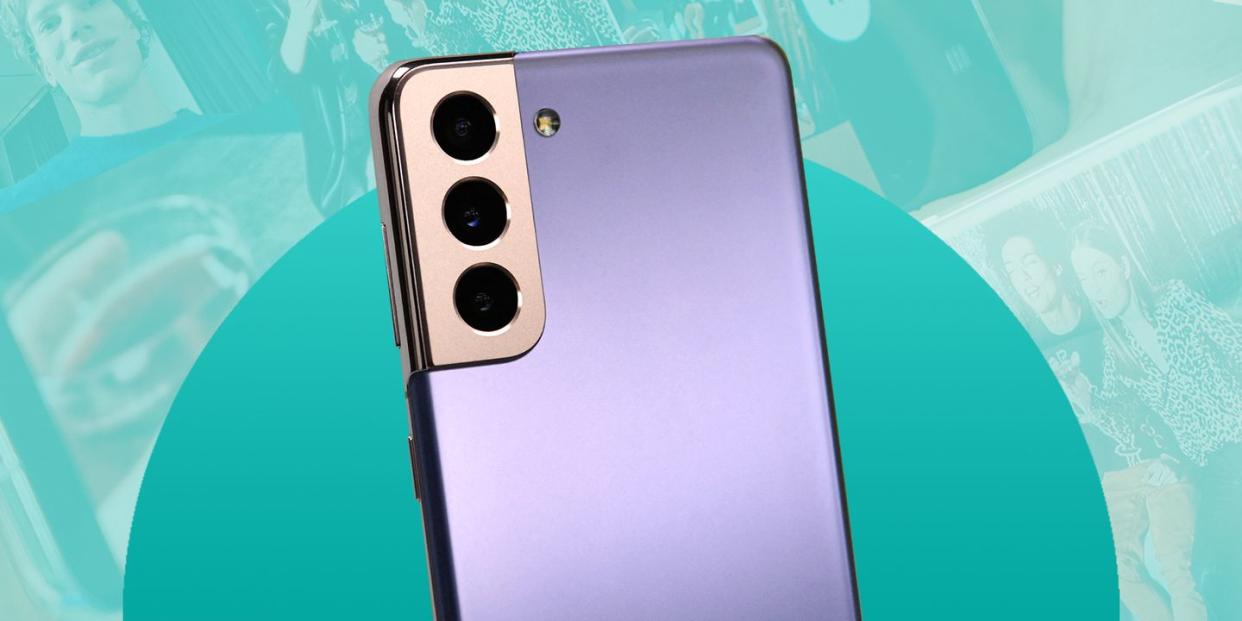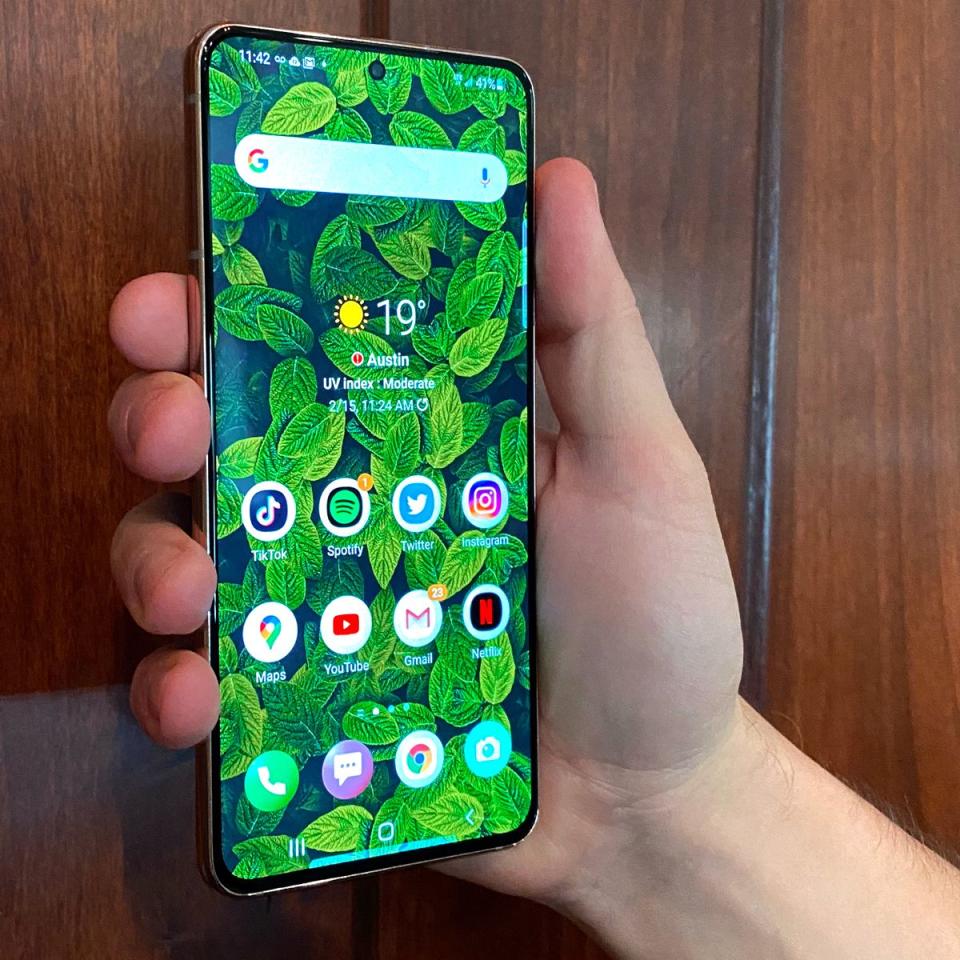The Samsung Galaxy S21 Is a Stellar Smartphone Without the Steep Price

With its latest Galaxy S21 smartphone, Samsung offers buyers a refined design, a high-end processor, and improved camera software for $200 less than its predecessor.
Samsung did things a little bit differently this year, which should come as no surprise considering a lot of things are different given the state of the world. For years, the tech giant’s Galaxy S series of smartphones has been the crème de la crème of its lineup. They’ve had the latest and greatest specs, the most amount of features, combined with best cameras.
This year, the $1,200 Samsung Galaxy S21 Ultra, which my colleague Stefan Vazharov reviewed, takes the crown as the do-everything feature-filled flagship.
According to CNBC, Samsung kept the costs down on the $799 Galaxy S21 to “help it appeal to a broader audience” considering the economic uncertainty people are facing in the pandemic.
KEY SPECS
• Qualcomm Snapdragon 888
• 6.2-inch flat FHD+ Dynamic AMOLED 2X display with 120 Hz maximum refresh rate and HDR10+ compatibility
• Triple camera with 12MP main, 64MP telephoto with 3x optical zoom, 12MP ultra wide, 10MP selfie camera
• 8GB of RAM, 128/256GB of storage
• 5G, Wi-Fi 6E connectivity
• 4,000 mAh, fast wired and wireless charging, reverse wireless charging
• Built-in stereo speakers, waterproof body
Over the course of a week and a half, I’ve been testing the Galaxy S21 to determine if there are enough compelling reasons to save some money and opt for the cheaper S21 over its much more expensive sibling, the Galaxy S21 Ultra.
After analyzing the phone’s design, software, performance, and comparing it against other Android and iOS smartphones I’ve previously used, here’s why I think the Galaxy S21 is worthy of your hard-earned dollars, as well as some reasons why you might want to opt for the more expensive S21 Ultra if your budget permits.
It’s Easier to Hold
Like its predecessor, the Galaxy S20, the S21 sports a similar design with its 6.2-inch display and punch-hole selfie camera at its top. There’s more than meets the eye, and the S21 now has flat edges as opposed to S20’s previously curved display.

I think this change is a good one, since it makes the phone a lot less slippery and easier to grip one-handed.
It’s worth mentioning that the S21 flaunts a matte plastic backside, rather than one made of glass, so it doesn’t feel as premium as other flagship devices, including the S21 Ultra. I think the phone feels great and found that it wasn’t as susceptible to fingerprints as other devices. Not to mention, it won’t shatter in the event you drop it. As a bonus, it’s completely waterproof.
Measuring in at 6 inches tall, 2.8 inches wide, 0.31 inches thick, and weighing 6.07 ounces, the Galaxy S21 is also significantly smaller than the Ultra, which checks in at 6.5 inches tall. For comparison's sake, the Pixel 5 is 5.7 inches tall and the iPhone 12 is 6.1 inches.
If you’re yearning for a larger screen, you can opt for the Plus version which touts a 6.7-inch display. Both models have stereo speakers tuned by AKG which deliver loud and clear audio. The phones even support Dolby Atmos tech to elevate your video-viewing experience.
The In-Screen Fingerprint Sensor Is a Gamechanger
Speaking of displays, the Galaxy S21 is equipped with a Full HD+ screen, which is a slight downgrade from the Quad HD display on last year’s model, since it’s lower in resolution. On the plus side, the device features an adaptive screen refresh rate that maxes out at 120Hz.
This means that depending on what you’re using your phone for, whether it’d be playing Call of Duty Mobile, watching Netflix, or just switching from Instagram to Chrome, the screen will automatically adjust scrolling and animation speeds to ensure you get a crisp and vivid experience while saving battery life in the process.
Another nice perk is the Galaxy S21’s nifty in-display fingerprint sensor. It’s 70% larger than the S20’s reader, is a lot faster at scanning, and it just feels more natural to scan your finger with. The majority of Android phones’ fingerprint scanners are typically found on the backside of devices, making them harder to reach. In the era of mask-wearing, fingerprint sensors are much more convenient than face scanners, too.
Ultra Zoom Camera Is Ultra Useful
Samsung’s Galaxy S21 packs a triple camera array which comprises of the following: a main 12MP wide lens, a 12MP ultra wide lens with a 120-degree field of view, and a 64MP telephoto lens that offers 3X optical zoom and a digital zoom up to 30X. Its front camera is 10 megapixels, as well, which captures excellent-quality selfies.
Compared to the Google Pixel 5, the S21 takes better photos and videos. Samsung’s algorithm and camera processing are top-notch. Images are outstandingly detailed and colorful, without being too saturated. The clarity is simply unmatched, especially when you’re outside. Even photos taken in low-light environments turn out well.
Where the cameras truly deliver is zoom performance. A new “zoom lock” setting uses artificial intelligence to identify subjects and automatically steadies your shot. Obviously, the more you zoom, the grainier quality gets — but photos taken at 10x zoom are sharp and totally useable. I could see this feature coming in handy for parents who try to take photos of their children at a recital or sporting event.
Perfectly Zippy Performance
The biggest upgrade to the Galaxy S21 is that it’s equipped with Qualcomm’s latest Snapdragon 888 processor, which delivers 20% better CPU performance and 35% more GPU speed than its predecessor. The S21 does only come with 8GB of RAM, which is 4GB less than the S20, but I think only power users who edit lots of videos would notice a difference.

I had no issues whatsoever running graphic-intensive games, multitasking, and using split-screen apps. The only time the device got slightly warm was when downloading large video files from Google Drive. Overall, the phone feels smooth and incredibly fast. I also appreciate that it supports Wi-Fi 6E and 5G.
Its battery performance is impressive, too. My battery lasted for 13 hours, which is likely an hour longer than you’d get using an iPhone 12. Unfortunately, the S21 does not come with a charging brick.
The Not-So-Damning Downsides
Besides lacking the charging brick, some other aspects in which the S21 falls short include its lack of a microSD card slot, a headphone jack, and MST. The latter is a contactless payment solution Samsung phones use that emulates magstripe terminals used by many credit card readers in stores across the United States.

Some smartphone fans may mourn the glass backside, but I think the plastic back is a fair compromise to make for the device’s lower price point. The biggest downside in my opinion is that the 256GB Galaxy S21 is only available in the phantom gray color. It’s disappointing that Samsung removed the microSD card slot, which will push folks toward higher-capacity devices, but limits its vibrant violet and pink color options to the 128GB model.
Wrap-Up
Does the Galaxy S21 prove that maybe less is more? I’d say so. I think if you’re in need of a new phone, you’ll be more than happy upgrading to the S21. It’s an attractive-looking waterproof device that packs powerful performance, outstanding cameras, long battery life, all for a lower price than its predecessor. And for those who want more, including improved zoom performance for photos, battery life, memory, and a bigger and better display you can well … spend more on the S21 Ultra instead.
Read More:
A Helpful Guide to Buying a New Android Smartphone
Our Full Review of Samsung's Galaxy Z Fold2 Smartphone
Pair Your New Galaxy With Samsung's Galaxy Buds Pro Earbuds
Follow BestProducts.com on Facebook, Instagram, Twitter, and Pinterest!
You Might Also Like

